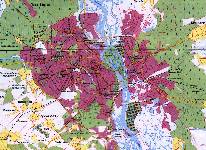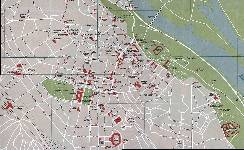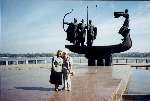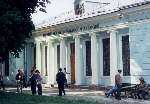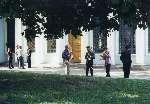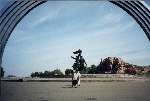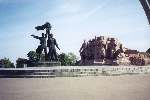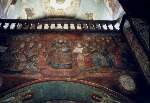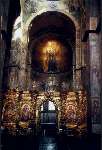|
Introduction |
TRIP TO UKRAINE
|
||
|
Tuesday, September 21, 1999 The next morning, since I had missed two days of the group tour of Kyiv, Dad very kindly hired a car, driver, and personal, English-speaking guide to conduct a whirl-wind tour for me. |
|||
|
But our first mission was to return to the Airport, where one of my bags was still being held (the bags reached Kyiv two days before I did) This turned into a major drama, as I had left my passport at the hotel desk (a routine requirement in many foreign countries, so the local police can make a record of your presence), and Soviet bureaucratic habits die hard. Fortunately, I had enough other identification, and our guide spoke Russian and knew the ropes, so after a lengthy negotiation she eventually triumphed, and we returned to Kyiv with my bag. |

|
||
|
We had to stop for gas. Its price was about $3 per gallon, and the pumps, as you can see, were somewhat primitive. That's our driver, Ivan. (Ivan was the most popular man's name among the people we met there.) $3 per gallon doesn't sound that high, especially today (2007), when prices here have reached that level, but in 1999 the average annual income in Ukraine was about $120 per month(!), so in crude terms, $3 to us was the equivalent of $75 to Ivan. Imagine having to spend $750 to fill up your tank! |
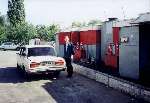
|
||
|
Driving back into the city,
our soaring, modern bridge (the Pivdennyi or Southern Bridge)
carried a Metro line as well as auto traffic. (I did get
to ride the Metro, though not this line.) Yes, this is the same bridge I had
crossed
by taxi the day before, and what astonishes me now is that on my first
crossing I
noticed neither its dramatic structure, nor the Metro trains - I was so
engrossed in the view of
Kiev!
Pivdennyi Bridge (southern bridge) designed by the architect A. Gavrilov and
engineered by G. B. Fux
was built in 1990. It is the second metro bridge in Kiev, serving both the
Syretsko-Pecherska metro
line and automobile traffic. The bridge currently has 3 traffic lanes in both
directions. It
connects the Vydubychi to the rapidly developing left bank Darnytsia
neighborhood, completing the
southern end of the "inner circle" road route. |
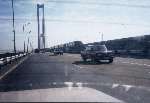
|
||
|
Anna, our guide, took us first to this park along the west bank of the river, and this monument to the founders of Kyiv, the brothers Kyi, Shchek, and Khoriv, and their sister Lybid. Across this part of the river lies a huge mid- river island park, with beaches, swimming pools, sports fields, etc. During summer months it is mobbed, but in spite of the fine, warm weather there was no one in sight there on this day. Beyond, you can see the tops of apartment towers. The monument was erected in 1982 to celebrate the 1500th anniversary of Kyiv's founding. |
 |
||
|
Ivan, our driver. The bridge in the background is the Metro Bridge
Metro Bridge engineered by G.B. Fux and Y. Inosov was built in 1965. The
bridge is used for both
the Sviatoshynsko-Brovarska Line of Kiev Metro and automobile traffic. It
links the central
Hydropark island as well as the left and right banks.
|
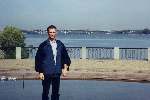
|
||
|
Standing at the monument, looking West, there is the enormous hilltop statue I had seen the day before on the drive in from the Airport. |
|||
|
Imposed on Kyiv in the early 1980's by the Russians, its Ukrainian name is Родина- мать (Rodina Mat'), but the locals call it variously "Mama Rus", Mother Motherland, Defense of the Motherland, Mother Ugliness, and Old Tintits. It is loathed and resented by the Ukrainians, who hate any reminder of the Soviets, but it would be too expensive to tear it down, so they live with it. It is commonly described as titanium, but is actually primarily aluminum. Its height is also a matter of dispute. Figures I found on the Internet ranged from "over 100 feet" to "350 feet". There is also disagreement as to whether it is taller than the spire of the Pechersk Monastery Bell Tower, which is otherwise the highest spire in Kyiv. Some say the statue was built intentionally taller than the monastery, to overshadow it, others that its height was reduced to avoid challenging the bell tower. One site claims the sword was shortened after Independence to reduce its height. Wikipedia, says "The statue itself is 62 meters tall, the overall height is 102 meters," and that the statue stands upon the "National Museum of the History of the Great Patriotic War of 1941-1945 years." |

|
||
|
We drove north along the embankment to this monument to the Ukrainian soldiers who died in WW II. Every town in Ukraine seems to have one. (Over 10 Million Ukrainians died in the war - that's 20% of all WW II casualties.) The spire of the Pechersk Lavra (Caves Monastery) bell tower is just visible on the left - it was closed that day, so we were unable to tour its famous church, monastery, caves, etc. |

|
||
|
More views of the WW II monument, with plaques to great heroes on left and right of walkway. "Kyiv Eternal Glory Park and Grave of the Unknown Soldier." In the 1950s a park was laid out in Pechersk district at the initiative of general A.Anusov, the commander of the Kyiv fortress. The park was called Anosovsky. In 1957 the park was converted into a memorial to the Eternal Glory of the Heroes of the Second World War (architects A.Miletsky, V.Baklanov,L Novikov) A 27-meter obelisk was erected above the tombs of the Unknown Soldier. Marshal V.Chuykov ignited the Eternal Flame. 34 Heroes of the defense and liberation of Kyiv, fallen for Motherland, were interred along the alley leading from Slava Square to the monument. The laying of wreaths on the tomb of Unknown Soldier became a sacred tradition. |

|
||
|
View looking East from the WW II monument. The old city is behind us. |
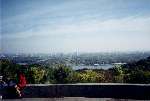
|
||
|
On the way to our next stop, driving north along the river - Hotel "Salyut" - One of the more unusual hotels in Kyiv. Note how few cars there are on the street, at noon on a Tuesday. We toured about ten sites in three hours, and parked easily at all of them, with minimal traffic in between. |
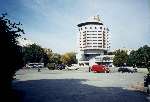
|
||
| Behind the Philharmonic Hall, musicians practice. | |||
|
Nearby, another huge monument, this one dedicated to "The Reunion of Russia and Ukraine". Another embarrassment the locals would prefer to be without, though the younger generation, to whom Soviet domination is already just a story told by their elders, accepts these Russian legacies as part of the landscape. This one is a popular site for wedding photos.
The Soviets did everything on an immense scale, as if the size conveyed validity. |
 |
||
|
Great views from the platform of the monument, though - See that statue in the trees near the center of the photo? It's Prince Volodymyr, the Baptizer of Rus. |
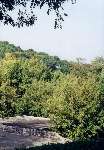
|
||
|
Looking North along the Dnieper, boats ready to carry people on day tours of the area near Kyiv, or up or down the River - Odessa is a popular destination. |

|
||
|
We jump back in the car, and it's just a short drive to St. Michael's Square, with its monument to Princess Olha (grandmother of Volodymyr, and the earliest leader of Rus to be baptized) flanked by Sts. Cyril and Methodius (two 9th century monks who developed the alphabet upon which the modern Cyrillic alphabet is based).
More history - |
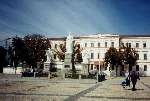
|
||
| Looking left, the bell tower of St Sophia Cathedral. |
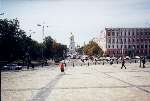
|
||
|
Looking right, the bell tower and domes of "St. Michael's Monastery of the Golden Roof", then being rebuilt, since completed. EVERYTHING in Kyiv has been or is being rebuilt, as 90% of the city was demolished in WW II. Churches were not welcome under the Soviets, of course, so most of those have been rebuilt in just the past ten years. |
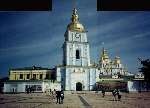
|
On our way to St Sophia Cathedral, we detoured a bit to see a busy street of artist's stalls and souvenirs, at the bottom of the steps to St. Andrew's Church. Note the soccer souvenirs hanging from the table - the Dynamos are the local team. The nesting dolls (matryoshka) are more a Russian tradition than Ukrainian, but tourists expect to find them here, so they are painted in traditional Ukrainian costumes. |
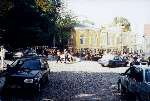
|
| St. Andrew's Church, which was closed that day. |
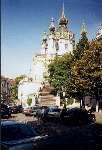
|
||
|
Near the foot of the steps to St. Andrews is this statue, a very recent gift to the city from a movie company (!) - it depicts two movie actors in their roles in the film, "After Two Hares," from the play by M. Staritskiy. (The title originates, I assume, from the old proverb - "If you run after two hares, you will catch neither.") |

|
||
|
It was just another short ride to St Sophia Cathedral. Our guide Anna explains the history of the building, which was modeled on Hagia Sophia in Constantinople (Istanbul), and looked like this model when first built, starting in 1037. Link to a picture of a wonderful diorama showing Kyiv shortly after St. Sophia was built. The view is to the north, with the Golden Gate at the bottom, and the Dnieper River at the top. St. Sophia is the largest building, left of center. |

|
||
| By the 18th century, it had evolved to this. |

|
||
|
Interior of St. Sophia. Fabulous frescoes and mosaics. The rate structure for admission to St. Sophia was interesting. There was one fee for general admission, another for admission to the second story, and another for the right to take still photographs (use of a camcorder would have required yet another fee to be paid). But it was all apparently an honor system, as no one checked our tickets once we were inside. I could have shot several rolls of film here - it was the most beautiful church we visited. Yes, we paid all the appropriate fees. |
|||
| The Bell Tower, from inside the grounds. |
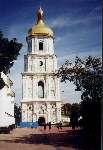
|
||
|
Our guide was a delight, and her fluent English spoiled me for the rest of the trip, which was mostly in Ukrainian. If I could do this again, I would retain her for two or three days, and skip the car - most of the interesting sights are within reasonable walking distance of one another, or one could take public transit. Another diorama of Kyiv in the 12th century - making it obvious why the location was chosen. |
|||
Send feedback to the author: CLICK HERE
Created -- 03/22/2007 Revised -- 03/22/2007
